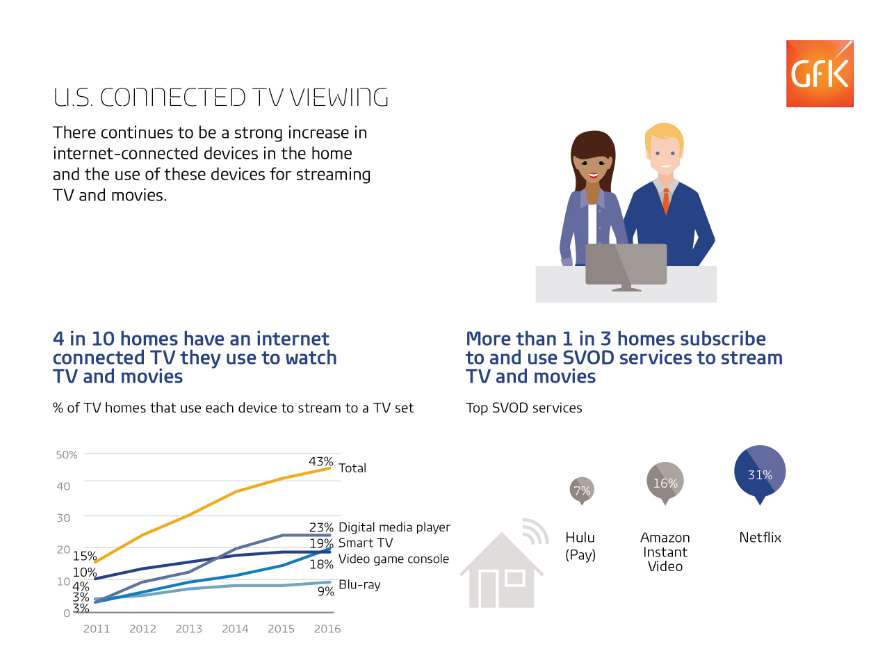
After more than 40 years of operation, DTVE is closing its doors and our website will no longer be updated daily. Thank you for all of your support.
Quarter of US TV homes now without pay TV
 One quarter of US TV households now go without a cable or satellite pay TV subscription, according to research by GfK.
One quarter of US TV households now go without a cable or satellite pay TV subscription, according to research by GfK.
According to GfK’s 2016 Ownership and Trend Report, part of its Home Technology Monitor, 17% of US TV homes now rely on over-the-air broadcast reception, up from 15% last year, while 6% only use internet TV services such as Netflix, Amazon Prime, Hulu or YouTube and have no broadcast or pay TV reception at all. The latter figure has increased from 4% last year.
The trend is accentuated among younger viewers. For TV homes with a resident between 18 and 34 years old, 22% are using over-the-air reception only, while 13% are only watching internet TV. In total, 38% of households with an 18-34 year-old resident rely on some kind of alternative TV reception or video source to traditional pay TV, against 25% of all homes.
Households with at least one resident over 50 are more likely to take cable or satellite services, with 82% taking a pay TV subscription. Forty-six per cent of these homes pay for a cable service, versus a US average of 41%.
Low-income households, meaning those with household income of less than US$30,000 (€27,000), are more likely to rely on over-the-air reception, with 26% of these homes taking broadcast-only TV. Hispanic households are also more likely to rely on over-the-air TV, with 24% of Hispanic homes taking broadcast-only.
High-income households, meaning those earning over US$50,000 are more likely to take satellite TV than the average, with 27% of these homes taking a satellite service against a US average of 21%.
Overall, cord-cutters have an average income of US$59,000, with 47% taking an SVoD service and 63% using OTT on TV. Some 37% of these households have children in the household. Cord-nevers have an average income of US$47,000, with 30% taking SVoD and 35% being active OTT-on-TV users. Twenty-six per cent have children.
The comparable figures for the overall population are an income of US$65,000, with 36% taking SVoD, 43% being active OTT-on-TV users and 31% having children.
According to GfK, four in 10 homes have an internet connected TV they use to watch TV and movies, with 23% connecting via some kind of digital media player, 19% via a smart TV portal, 18% via a video game console and 9% via a Blu-ray player.
Thirty-one per cent of US homes take Netflix, with 16% taking Amazon Instant Video and 7% taking Hulu’s pay service, according to the research group.
“The fact that a statistically significant increase in broadcast-only reception occurred over just one year may be further proof that the cord-cutting/cord-never phenomenon is accelerating,” said David Tice, SVP in GfK’s Media & Entertainment practice.
“If you include homes that have no TVs at all – about 3% of all households – then less than three quarters – 73% – of US homes continue to have pay TV service, with the attendant implications for all stakeholders – not just the pay TV services themselves, but also networks, content providers, and advertisers.”


